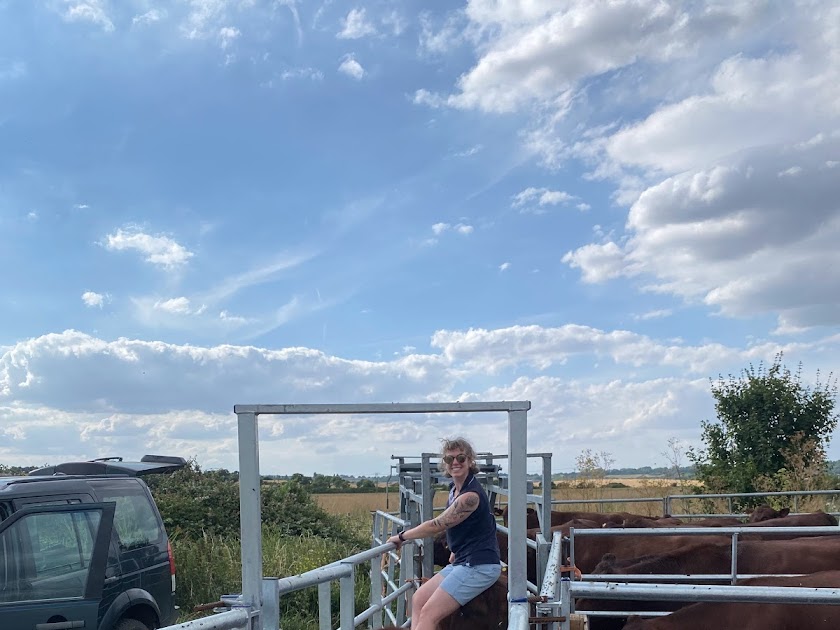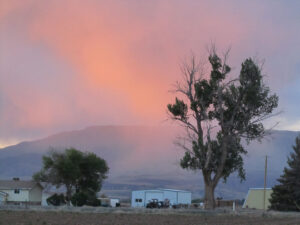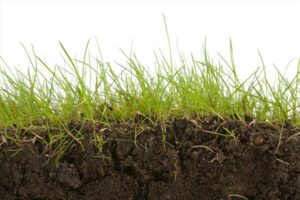Since they were only four or five months old, I didn’t want to wean them from their mums at this stage, so consequently I separated them off from the herd too, with the little ‘bull herd’ of five animals to be moved to one of the new meadows that I created with the recent fencing project.
The bull had been in for eight weeks, and Mia was lending me a hand in the evening after work (very useful for the fiancé to be a vet!). It therefore seemed sensible to scan the cows that I was removing to see if they were pregnant at that stage. Since they would continue to run with the bull, if they were scanned empty, we would know that they may get out of sync with the rest of the cows (i.e. they might calve later). Not the end of the world, but handy information to have.
As it happened, both Cow-101 and Cow-614 were in-calf (Mia is able to judge once they are about 30 days in-calf, and at that stage can even say how many days in-calf they are!). This was great news. Clearly these are two very fertile cows. Just out of interest, I also asked Mia to scan Cow-134, Yara. She was the old heifer I bought, who took ages to get in-calf last time, and was far and away the last cow to calve. Surely there would be no chance for her to be in-calf. Even more so since cows don’t actively menstrually cycle for at least 42 days after calving. However, no-one told Yara that, and in fact she had managed to get in-calf just 30 days after her calf was born! This is incredibly exciting. However, I am not counting my chickens yet. She was only 35 days pregnant when Mia scanned her, and it would be easy for her to slip the calf that early on (especially given the excess heat of late). We will see when we scan the rest of the herd in September and re-check her then.
In the week before Kestrel came out, I had noticed him being rather lame on a back hoof. On inspection, there seemed to be only a very minor lesion between his claws. But it was certainly giving the big fella gip. It is common for bulls to come out of running with the cows lame having been up on their back legs so much anyway. So I wasn’t hugely concerned, and we gave him long acting pain relief when he was in the crush having his vaccination. It is so incredibly dry at the moment too, so an amount of lameness is not surprising when the ground is like concrete.
Two days later it was much worse though. The lesion has swelled and then finally erupted, with a large crater left between the claws (enlarged due to the swelling on the ankle). Naturally I was very concerned. Kestrel still has two more servings to conduct here in Fobbing before I will sell him on to another farmer. I therefore put up a small pen in his meadow and moved the crush over to it so I could investigate further. With all the excess heat, fly pressure and maggots is a serious worry: they love an open wound.
 |
| Kestrel’s foot looking pretty nasty. |
Like many bulls, Kestrel knows that he is a big boy, and he can often be quite obstinate. So, driving him or calling him to the crush was never going to work. Luckily he does have a nose ring, a tool which I hate using, and do so only very rarely, but in a situation like this – absolutely crucial. Hooking a forefinger into it, he became reasonably compliant, and I could walk him all the way to the crush and get him safely restrained.
The foot looked bad, but I really didn’t want to be injecting antibiotics at this stage. We also didn’t want to bandage the foot given the heat, worrying that maggots might get behind the bandage. Instead, Mia suggested using some green zinc and copper sulphate goop, which I liberally lathered on with a paintbrush.
 |
| On the mend but slowly. |
 |
| With a bit of patience, mostly healed. |
With repeated applications, the wound began to get better. And lameness diminished to nothing. But still by the middle of August it has yet to heal fully, although I know he is on the road to full recovery, and has another few months of rest before he will serve the Autumn-calving cows.
On 15th July we cut the hay on the Essex Wildlife Trust marshes. This was ready to bale in just a couple of days with no additional work: the hay just made on the ground in the incredible heat. And Theobalds came in as usual to contract bale it for us.
I had been keeping an eye on our wheat which felt like it was approaching fitness. Whilst Paul cut the hay in the tractor that Friday, I holed myself up in the grain stores giving them as thorough clean as I could manage in a day, knowing that harvest was gnashing at my heels. On the Saturday I went to look at my crop of Winter-sown wheat on the hill in Fobbing and I couldn’t believe it. The crop was fit and ready to go!
I rang Paul to ask him to come in to start harvest on the Sunday, and then set about organising everything else I needed to: jet washing and disinfecting all the trailers, getting all machinery greased-up & dieselled-up, checking tyre pressures on the fleet etc. A very frenetic day when I was meant to be socialising with Mia’s friends and instead had to just apologise to them when I finally came in at 8pm, covered in dust, sweat and grime!
 |
| The earliest start to harvesting wheat for at least 45 years! |
Harvest started smoothly the next day, and we battled through the two insanely hot days, reaching 39 degrees here in Fobbing. I managed to get my heritage wheats all cut and in the barn too. These are a little more tricky since the combine needed cleaning out between each different variety (there were eleven). So exceptionally satisfying to have them safely in the store.
 |
| A moody tattoo shot in front of the heritage wheat (notice the wheat ear on my arm) |
 |
| Heritage wheats safely in the barn. |
I had also been keeping an eye on my crop of beans – the final field at home to be cut before travelling to North Ockendon for the rest of harvest. Usually beans aren’t ready until the end of August or early September. However, they had rapidly turned brown and died, and on checking them they were under the necessary moisture content. So, at 5am on Thursday 21st July, we managed to harvest that crop too. All of the top pods had aborted due to the heat and drought, so the yield was less than it could have been. However, at 3.8t/ha I was still ecstatic with that.
 |
| Beans harvested in the middle of July. |
 |
| Lovely looking sample. |
 |
| Beans. Usually the stem is black like the pods, but this year with all the top pods aborted, we could cut early and have the stem green. |
Two days later Paul, our long-term employee of over 26 years, decided to resign from the job, leaving the harvest to be completed by me. Luckily Dad is still about and was happy to step out of retirement and help with corn-cart whilst I drove the combine. Luckier still that I had ensured that I knew how to drive all the machinery! So I cracked on and cut the lentils for Hodmedod, before moving onto the last of the Winter wheat.
 |
| Lentil harvest from the combine seat. |
That week I had also booked Anglia Grain Seed Cleaners in to come and sort out my wheat seed which will be established at the end of September / early October. Whilst I have my small-scale seed cleaning kit set up in the barn now, it is one thing to clean a tonne or two to run through the mill, but quite another to run 50 tonne through! So it made sense to get the big guns in to crack through that quantity in good time. It is now all bagged and waiting for the weather to change!
 |
| Anglia Grain seed cleaners doing a super job. |
As it stands there is still no rain in the forecast for August, so I am confident that we will crack through the rest of harvest without any weather issues. It has been the earliest start for decades, and unless something goes awry, it will be the earliest finish too. I am just getting seriously concerned about the lack of rain now. We have had drought periods before, but never a time with zero rainfall coupled with intense prolonged heat too.

















Haha, spot on! ??